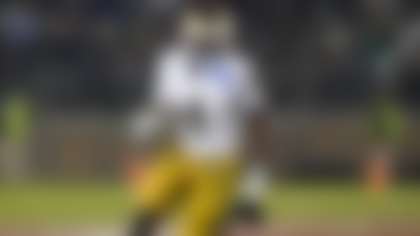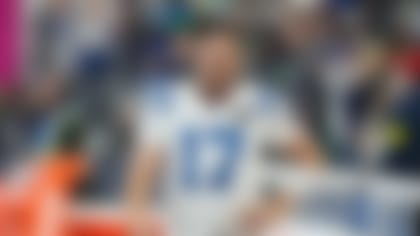The murmurs are growing in the Black Hole. Raiders fans are disenchanted with watching JaMarcus Russell struggle as the team's franchise quarterback.
The former No. 1 overall pick has turned in three abysmal performances to open the season, and his play has appeared to regress in his second full season as the Raiders' starter. Whereas coach Tom Cable and the organization have remained steadfast in support of their young quarterback, there is a growing sentiment that Russell may fail to live up to lofty expectations.
The cynicism that surrounds Russell's performance is warranted, given his dreadful numbers. Russell is currently completing only 41.3 percent of his passes with one touchdown and four interceptions, for an appalling 39.6 passer rating. For now, it's not unfair to compare Russell's play to the flameouts of other highly drafted quarterbacks of this decade.
Billick down on Russell
NFL Network analyst Brian Billick was asked during his weekly chat what he would do with Raiders QB JaMarcus Russell if he were head coach.
"I've not seen much in the play of Russell over the last three weeks to indicate any expectation for improvement. If he were a rookie, and just now playing in his third game, you could make some case for the lack of his productivity. But being in his third year in the league, and given that lack of productivity, I'm not sure what you're hanging your expectations on for improvement.
"The unknown part of the equation is that if you don't have anyone behind him to put in, that changes the price of poker in this game." **Full chat ...**
David Carr and Alex Smith also failed to make the grade as franchise quarterbacks after entering the league as No. 1 overall picks. They are joined by Matt Leinart and Vince Young as notable disappointments at the position. With their struggles firmly entrenched in the minds of many, it is not surprising that Russell is quickly being tossed on the scrap heap by some observers.
Russell, who entered the league touted as one of the most physically gifted quarterbacks to come out of college, has only shown glimpses of his immense potential. While he has dazzled some with his exceptional arm strength, his suspect accuracy and questionable anticipation have overshadowed his natural talent. Moreover, his inconsistencies as a passer have drawn attention to the flaws in his mechanics in the pocket.
Whereas elite quarterbacks exhibit quiet feet in the pocket, Russell often delivers the ball while falling away from the throw with all of his weight on his back foot. Though he is occasionally able to complete passes due to his exceptional arm strength, the flawed mechanics often result in high throws that routinely land in the hands of defenders.
Russell's high-turnover rate also draws attention to his inability to anticipate open windows in coverage. While this partially can be attributed to his inexperience reading complex coverages, it also is a testament to his lack of confidence in his playmakers. Some quarterbacks trust their receivers to go get the ball in tight spots, but Russell appears unsure when to let the ball go to his pass catchers on the perimeter. This hesitation in the pocket has also resulted in Russell taking a high number of sacks; he was taken down 31 times last season (ninth-most in the league), and has already been sacked six times in 2009.
Of course, some of Russell's troubles can be described as self-inflicted since the third-year pro missed all of training camp as a rookie while haggling over a contract. The protracted absence put Russell severely behind in his development and the young QB has been playing catch-up ever since. Throw in reports about Russell's weight problems and questionable work habits, and his uneven performance falls directly on his shoulders.
That said, closer examination of Russell's game suggests he may not be solely responsible for the disappointing start to his career. He has played under three different play-callers (Lane Kiffin, Greg Knapp and Tom Cable) during his time with the team, and constant turnover in coaches has stunted his growth as a player. With each new coordinator bringing a different philosophy, Russell has failed to fully grasp the nuances of the offense, which is reflected in his inability to fully work through his progressions.
The Raiders, under Cable, remain an offense that wants to grind it out behind a physical ground game complemented by an explosive vertical aerial attack. But the unit has struggled getting untracked during the first part of the season and ranks only 20th in rush offense (103 rushing yards per game). With the team unable to run consistently, more responsibility has fallen on Russell to carry the team's offense through the air, and the results have been disappointing.
While Russell's aforementioned mechanical flaws are partially responsible for the passing game woes, the fact that the receiving corps is loaded with inexperience is another factor in the lack of success. Darrius Heyward-Bey and Louis Murphy are rookie starters still acclimating to the pro game, and the backups (Johnnie Lee Higgins and Todd Watkins) have combined for only five career starts with the team. Therefore, it is not surprising to see the Raiders' aerial attack experience the ups and downs that typically come with playing young players at key positions.
Logical explanations will not stop Raider Nation from calling for Russell's benching, but followers of the Silver and Black may be wise to exhibit some patience with their franchise quarterback. Russell's plight may mirror the ascension of a former No. 1 overall pick in New York.
Eli Manning, the top pick in the 2004 draft, enjoyed a similar start to his career after being thrust into the starting lineup as a rookie. The future Super Bowl MVP completed only 48.2 percent of his passes during seven starts that season and compiled a dismal 55.4 passer rating. Manning gradually improved as a pocket passer by improving his completion percentage almost every year (52.8 percent in 2005; 57.7 percent in 2006; 56.1 percent in 2007; career-high 60.2 percent last season).
However, there is a notable difference between the two situations.
The Giants provided Manning with a stable environment to foster his success as a franchise quarterback. Offensive coordinator Kevin Gilbride has been with Manning since his rookie season, and the ability to play within the same system for his entire career has enabled the Giants' star to develop at a gradual pace.
In addition to stability at the play-caller spot, the Giants surrounded Manning with a strong running game and an experienced receiving corps. The Giants have ranked among the top 10 rushing offenses each season since 2005. Veteran receivers Amani Toomer and Plaxico Burress were in place to give the young QB a pair of dependable options in the passing game. Those factors alleviated the pressure on Manning and allowed the Giants' offense to thrive in spite of his mistakes in the pocket (Manning never posted a passer rating higher than 77.0 in his first four seasons before his career-best 86.4 rating last year).
Although Manning and Russell clearly are in different situations, the success of the Giants' star should serve as inspiration for those looking for a silver lining in Oakland. The development of an elite quarterback is a gradual process that requires time and patience before the benefits can be reaped.
With their franchise quarterback undergoing a bad case of growing pains, the Raiders' faithful can only hope their patience will be rewarded in the foreseeable future.




